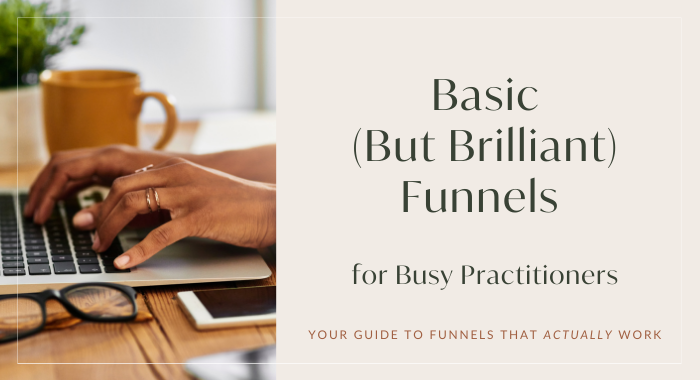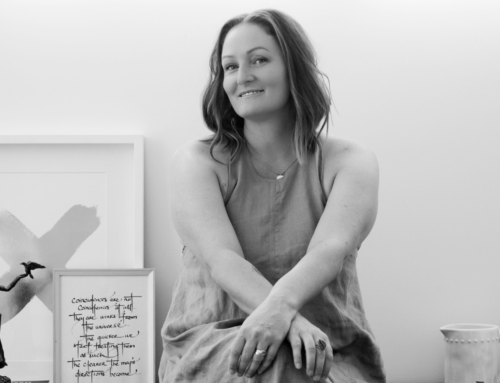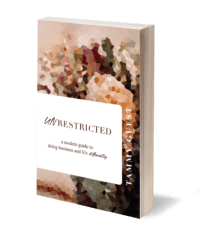I want to start the conversation about finding your niche. I’ve had so many questions about this topic, both in the Hub and just via many emails from clients.
This is an interesting topic because it’s a relatively big conversation on one side but then it’s also a super easy conversation on the other side.
As I said, it can be super simple – in essence, it’s just picking one thing and one person to focus on, right?
But then there’s all this other stuff that can go with it. There will be three parts to this training, so watch for the videos for Part Two and Part Three.
Let’s get started with Part 1: A scientific method to finding your niche.
A Scientific Method to Finding Your Niche
What is a ‘scientific method?’ By definition it is:
“A method or procedure, a systematic observation, measurement, experiment, and the formulation, testing, and modification of a hypothesis.”
Back in the day, I was a scientist. I worked in a morgue, I did cancer research in a couple of different places, and I worked in a laboratory. I also did research for pathology before I got into pathology as an actual field of research. I was really keen on wanting to know how everything worked.
The only way to know how everything works is to find one thing and find out how it works. But you have to isolate one part of that one thing and how it works in order to actually create a scientific hypothesis. Then, you test whether or not your hypothesis is true. A hypothesis is an idea that might come from thought, something that you heard, it might come from an observation you’ve made and you want to explore that.
Create a hypothesis
To apply the scientific method to business means you might have had a thought that you’d like to help a particular type of symptomology or a particular type of person.
So your hypothesis would be, “I could help these particular types of people.” The scientific method says that you can only do one thing, so that would the one thing and you would then only be testing one part of that.
Bizarrely enough, I started my Master’s but I didn’t follow through because I was so excited about so many aspects of what I was studying. At the time, it was actually live blood analysis. You can’t create scientific research on the whole field of live blood analysis. I had to pick one type of cell, so I picked lymphocytes. And then of those, I had to pick one differentiating feature to test my hypothesis.
You can see how being a generalist and wanting to serve everybody and testing all of the different types of conditions out there or people out there isn’t going to really get you a very specific result when it comes to using the scientific method for nicheing.
So I started my Master’s on that and because, again, I was so interested in all of the different facets, I realised that I couldn’t keep going on with just this tiny little focus.
The flip side to that is that in business when we do all the generalised things, we can’t get a specific result. So it’s hard to test our hypothesis of whether or not we are serving one particular person unless we start to market to that one particular person (or one particular disease state or symptomology). If we are doing that and we are choosing one path, then we need to go through with systematic observation (as identified by the scientific method). Then you’ve got to go through the background research of that particular person hypothesis.
When it comes to who you would like to serve, it’s a hypothesis as to whether or not that person is going to work out for you. Don’t think, “I’m going to serve everybody.” Because what happens when you say you’re going to serve everybody is you don’t get a specific result and you can’t test it. Just like when I wanted to do all of the blood cells and I couldn’t get a specific result of whether or not part of this works or part of it doesn’t because I haven’t actually picked one.
So when we pick one, then we have an opportunity to test it. We can go and get background research on all of it. When I began my (unfinished) Master’s, I did a full lit review and got all of the bits and pieces to do with what I was studying. Since I was studying lymphocyte, I got all of the literature reviews on how that has been used before.
The same thing happens for when you have hypotheses.
Say I want to help burnt-out mums. So I have researched burnt out mums like you wouldn’t believe. I’ve researched them inside and out . I researched:
- what they like
- what they didn’t like
- where they were on Facebook
- what they were Googling
- what they said to their friends
- what they said to themselves late at night
- what was going on inside their heads
- their biggest, most hardcore challenge
- what they feared the most
- what really inspired them to change things
- what they really wanted out of their health and well-being
- and what was happening in most of their bodies that they were either not happy about or they wanted or needed to change
There’s a whole bunch of stuff to learn. Check out my Ideal Client Download and you can really hone in on it.
You’ve got to do your background research so finding and utilising it as a hypothesis such as, “I want to help this particular person,” you then have to really get into their boots, into their world, and essentially do a literature review on all of the different places and spaces that they inhabit. Where they have bought things or things they have looked up that have to do with their health and well-being. Then you’ve got to create an experiment.
Create an experiment
Now, this is the fun part of finding your niche!
Remember, it is an experiment. It’s not the be-all and end-all. I resisted this so much when I first heard this. For about six months I was like, “No! I want to help everybody. My natural health skills can help everybody in the world.” And that’s fine except, I can’t speak to everybody in the world.
What you’re doing when you define a niche is you’re speaking to one particular person and giving them a spotlight.
So now, you are looking at one particular hypothesis and giving it a spotlight. There’s gonna be ambient light around there that’s going to fall on other people. Those people don’t just magically disappear, you’re still gonna get them. When I was doing my literature review, I still found things on lymphocytes and other testing modalities and all of this other stuff. But I was looking just at them so I could focus my attention.
It’s the same thing with your niche. You focus your attention there.
There’s still going to be other mums who are going to come into your world. There will be other mums, their partners and families, their kids – they’re all still going to get in there. It’s not like they just disappear. It’s not set in stone and concrete that they can’t come to you anymore. It doesn’t work like that.
One of our biggest fears, especially when we’re first starting out, is that if we niche, no one will come. But that’s not the case. When we niche, we really get the people that we truly are experimenting on whether we can help them or not and we’re seeing how we can help them the best, what gives the best results for this particular group of people, and then once the experiment is done, you might find something.
Keep an open mind
This is the same case with the scientific method. You have a hypothesis, you do background research, and then you run an experiment. It’s important to go into the experiment without expecting an outcome. Stay really open-minded about whether or not it’s going to work. Of course, you want it to work because your hypothesis is that this particular thing will work.
But this is the thing about science, right? You’ve got to go in with an open mind because sometimes these things don’t work.
When I was back in cancer research, we were doing some chemotherapeutic drug reactions on the CD City 35 which is a protein on the edge of a colon cancer. We did a very specific test on one protein on the outside of one cell. ONE protein on the outside of ONE different type of cell. When we were doing that, we were in there testing one particular thing and seeing whether or not it switched it on or switched it off. It was as simple as that. We did that for about a month and just replicated it, replicated it, replicated it, replicated it, and replicated it until we had enough experiments to show that that didn’t work.
So for a whole month we tested, tested, tested, tested, and tested. We grew all these cells and then we tested them all and they didn’t die. So that particular chemotherapeutic agent didn’t work. But we had a hypothesis that it did work and we went into it with the idea that maybe this would work.
You can apply the same kind of process to your business. You can say you’re going to experiment with serving a whole bunch of amazing burnt-out mums that really need my help. So you go in and research them and then you test whether or not a particular:
- advertisement will work
- blog post will get them in
- a story that you share on your Facebook page works
And you start having the conversation and be open that some of these things won’t work.
Maybe if you share inspirational quotes for your tribe of mums, that might be really helpful. Or maybe for your tribe of mums, recipes might be better.
You’re sharing in a way and seeing what result you get back. You don’t do that just once and then decide that mums aren’t for you. You don’t do just one blog post or just one Facebook post. It’s a series of experiments to see which angle and what things work to really open up that mum to respond with, “Oh my goodness, that hit me. That was exactly what I needed to hear on the medium or the platform I needed to hear it, so I’m going to either post a comment, like it, or book in with you.”
You need to know whether or not it’s working, you need to know it over time, and it needs to be replicable. That’s what the scientific method is about. When you’re doing it with your peeps, you’re starting to have a conversation and you’re going to see whether or not the result comes back, and you’re going to do that multiple time.
Experiment for at least a month
Big companies do this over a whole year but when you’re just starting out, the minimum you want to be doing this for is at least a month.
If you want to focus on one particular symptomology, say choosing clients with IBS, then for a whole month, you put out all of your information about IBS. You put out a workshop, maybe a webinar, and the most recent research about IBS. You talk about it in your Instagram posts, put up pictures and helpful things that you’ve been exploring, post inspirational things, funny things about having the farts. Do it for a whole month.
If you’re inclined and a bit further on in your business, then I’d suggest you do it for three months. A quarter is a really good amount of time in a marketing strategy to really see what kind of result you get. We do the same thing all the time with our clients. You don’t tell your client to try a probiotic for one day and then ask them to tell you what happens. It doesn’t work like that, right?
It takes time for these experiments to reap the benefits of whether or not they worked. Then once you’ve applied that scientific method, once you’ve applied that experiment, you’re then measuring the result. This is the bit that takes a little bit of time to understand.
Measure results in many places
Measuring the result when it comes to niching is coming from lots of different angles in your business. Sometimes it’s how many hits you get on your on your website, so you have to start exploring what type of hit rate and click rate you have on your website. If you haven’t done that before, go and search YouTube for it. You’re going to find something depending on what platform you’re using for your website.
- Google Analytics does an amazing job of that and if you don’t have that on your website, you might wanna check that out. You’ll be able to see how many visits you’ve gotten and how long they stay there.
- Facebook has amazing measuring tools that give you lots and lots of amazing data. Go to the settings for your Facebook Business Page and go to the Insights section. You’ll be able to see what time of day people are clicking, what posts are getting the most engagement, what time of the day. There’s a whole bunch of stuff in there that could be really beneficial for you to get the measurements on whether or not that particular niche is working for you.
Then you want to test it, see whether or not that’s working with something a little bit bigger like a workshop, a webinar, or something a little bit different. Then you’ve got a full, round circle of the scientific method. You’ve had your processes and done background research. You’ve given it a good experiment time and measured it, got some data and numbers, and then you can decide that yes that’s working or no, I need to pivot and change.
That’s the cool thing about the scientific method and entrepreneurship crossover. You can pivot and change. Modify is the word – “modification of hypothesis.”
You can modify it and decide to help women with IBS instead of stress. So you modify and change your hypothesis, and then you do another experiment. And then modifying and changing.
This is a cool thing. The hypothesis itself or that niche itself is usually inside you. I’m going to talk about that next time, that it’s usually somewhere from your past – either a story that you’ve been involved in someone else’s life or a story from your life. It’ll be coming through to niggle at you as to whether or not that’s your niche. And then you experiment.
Pick something and experiment
My invitation to you at the end of all of this is to pick one niggling thing and see what experimenting gives you over a month. Do your research and show up in the places for that particular person, and get the measurements. I know numbers can be a little bit icky for us praccies, but lean in and get the measurements. Then modify and see what happens as a result.
It’s an amazing thing to be super curious! I love applying things and experimenting with stuff. It’s one of my favourite entrepreneurial tools and I think it can be really beneficial for you if you don’t know what your niche is so you’re just talking to everybody. It doesn’t work well because it’s diluted.
Here’s another chemical way of describing it. If you’ve got one little message and it’s like a shot of cordial and you pour that shot of cordial into a large cup, it’s nice and concentrated if it’s for one person. But if it’s for more people, then you’ve got to dilute it down with some water. Then we have a diluted cordial, which is okay, but it’s not like the shot of cordial, right?
Then if you want to keep talking to other people and you make it even more generalised, you’re diluting it even more. You’re adding a whole bunch of people on top and then your message gets so diluted that who wants that cordial at all? We want hardcore beautiful elderberry yumminess that’s as concentrated and directed as it can be not diluted in a whole sea of water.
Instead of diluting your message, hone in on it. Have an experiment to see whether or not it gets the benefits.
Take action
Hopefully, this was helpful! If it is, please share it or continue this conversation with some of your praccie friends. See how this plays out in your business or how you can take on even one little bit of what I was talking about. See if you can create your own experiment!
Where to from here?
Explore Part 2: Watch the video here.
Explore Part 3: Coming Soon









Leave A Comment